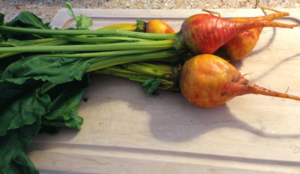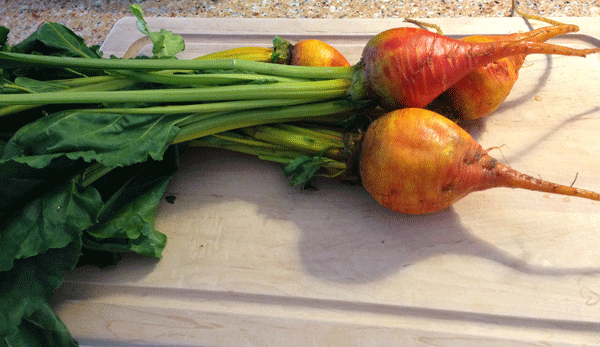 Beets are the ultimate in nutritional usefulness. Each part of the beet is nutritionally useful, and even the few small parts you don’t want to eat can be fed to your garden in the form of compost.
Beets are the ultimate in nutritional usefulness. Each part of the beet is nutritionally useful, and even the few small parts you don’t want to eat can be fed to your garden in the form of compost.
Golden beets are beautiful and sweet, and according to some sources are much lower in starch than their red cousins. So if you are reducing starch in your diet for health reasons, golden beets are OK! Also, red beets are a pain with their sheer redness, which gets all over everything in your kitchen. I’ve already got stains on everything from all the turmeric I’m consuming, and add the red “blood” from beets and I’ve got sunset-colored cutting boards and wood-handled knives, not to mention my hands… Ah the price for health. But I digress…
Beets can be divided into three uniquely useful parts: the roots, the stems, and the leaves.
Roots: The root bulb is the most deliciously sweet part of the plant. The easiest way to cook the beet root is in foil packets on your grill (btw you can skip the peeling step and eat them with the peel on). Another way is to simply peel them and steam them, then drizzle with a little olive oil and salt and serve warm.
Stems: The stems of the beets are great for smoothies and soup stocks. I often cut them in half and store them in a freezer-grade zip lock bag in the freezer until I need them. When using them in a smoothie or soup (or stock) you don’t even need to thaw them, just throw them right in frozen!
Greens: Beet greens are excellent when combined with a sweet vegetable (think carrots, fennel, or sweet onions) and sauteed with some fresh minced garlic and olive oil.
All parts have similar nutritional value, with plenty of folate, manganese, potassium, copper, magnesium, B6, vitamin C, and iron! And don’t forget the fiber, which aids in healthy digestion and protects the immune system.
When you buy beets whole you can store them intact for a couple of days in the refrigerator. They should be stored loosely in bags with the roots toward the back. When ready to use, trim the beets into their separate parts and store the unused parts for later. Place the leaves in a ziplock bag in the refrigerator with some damp paper towels (wash now or later, it doesn’t matter). The roots should be dried off and then put into their own airtight bag and stored in the veggie drawer of your frig. The stems can go in the freezer, also in an airtight bag or container. Greens will last about a week, and roots will last about two weeks. The stems can be kept for months.
In my book, beets are right up there with all the other great superfoods and you should eat them as often as possible (organic of course!).

